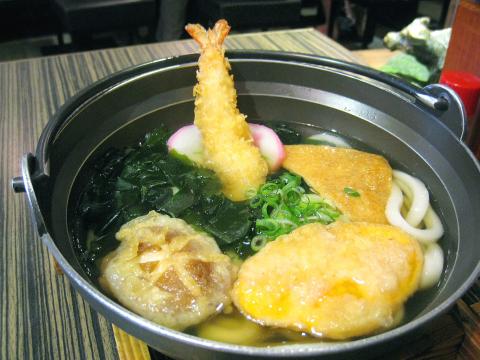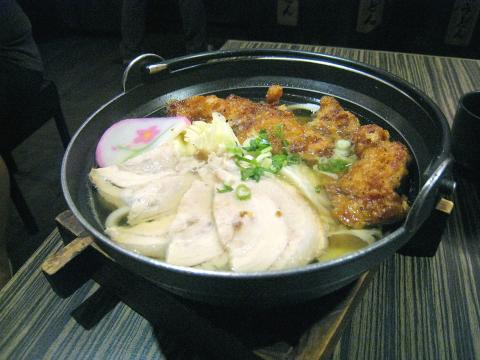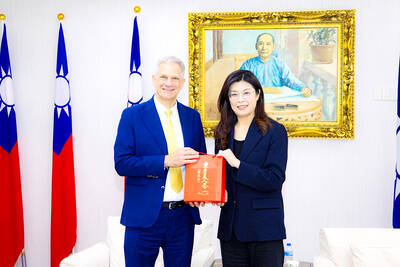With the recent opening of Hokkaido Ramen Santouka (山頭火, see the May 10, 2012, edition of the Taipei Times) and Ippudo TW (一風堂, see the May 17, 2012, edition), Taipei can officially be said to be in the grip of a ramen noodle craze. Both stores specialize in the serving of this Japanese-style noodle, and they have jointly raised the bar considerably for any establishment purporting to purvey Japanese style ramen. This fact underlines the suspicion long held that quality noodles are best obtained from shops specializing in the making and serving of a specific type of noodle.
The situation with ramen applies to other types of noodles as well. The best of various styles of northern Chinese-cut noodles (刀削麵), pulled noodles (拉麵), and southern-style egg noodles (雞蛋麵) are generally obtained from shops that make their own. If you are looking for a dish in which the noodle can stand up as the main event, mass-produced noodles just do not cut it.
With this in mind, I was particularly eager to check out Dosan Kanroku (土三寒六), a shop specializing in the Japanese udon noodle, and one that has been nominated by the Kagawa prefectural government as an “embassy for Japanese udon” (烏龍麵大使館), the official home of udon.

Photo: Ian Bartholomew, Taipei Times
My prior experience with udon in Taiwan had been of a flaccid noodle that failed to provide much interest in either taste or texture. They are a ubiquitous hot pot favorite, but one that I generally avoid as providing nothing more than a carbohydrate filler. As a result, my first experience of the cold udon noodles with salmon sashimi (NT$270 to NT$330) at Dosan Kanroku was a revelation. The noodles were fat and firm, with a robust texture that contrasted with their subtle flavor. You did not just slurp them in, but chewed them, coming to grips with their complex mix of qualities. Quite simply, these are exciting noodles. They’re made fresh daily, and can also be purchased for preparation at home (NT$180 a packet).
The bowl of udon with salmon sashimi was very simple, garnished with four thin slices of raw salmon that looked at first glance a trifle inadequate, but which proved sufficient flavor highlights to the noodles and the broth. I had requested the addition of a mountain yam (山藥) puree, a recommended optional extra (NT$50), and this provided an additional level of complexity.
The dish was a relatively new addition to the menu, and ideal for the current hot weather.

Photo: Ian Bartholomew, Taipei Times
The connoisseur’s udon (NT$260 to NT$290), a staple of the menu, which staff said was a favorite with Japanese guests, is also served cold, and includes a topping of tempura, including shrimp, mushroom, pumpkin, as well as tofu (there are seasonal variations to this combination). The mixture of slightly sweet tofu with the salty broth was a flavor combination that I associate very much with Japanese cuisine and one that is not altogether to my taste. It was telling that despite the lack of any instinctive fondness for this dish, the care in its preparation and the balancing of flavors was evident throughout, and it could be enjoyed for its pure craftsmanship.
Both the salmon and the connoisseur’s udon bowls were manifestly designed as “healthy cuisine.” They were low on oil and low on meat, and while this aspect of low-fat, low-calorie dining is something that Dosan Kanroku is keen to promote, there are plenty of hearty dishes that can fulfill the cravings of unrepentant carnivores. A fine example of this is the kingdom udon (NT$250 to NT$280), which is much the same udon bowl, served hot with a topping of roast fatty pork and deep fried chicken pieces.
The thin slices of roast pork were of superior quality, but not awe-inspiring, but the presence of large chucks of tender fried chicken, all crispy outside and falling apart within, were a benison to a hungry meat eater. Against the hot broth and the strong flavors of the meat the udon noodles manage to hold their own, but naturally do not have quite the pride of place they command in the cold dishes.
It should be noted that the broth in all these dishes has been carefully-crafted and is also one of the highlights of Dosan Kanroku’s udon dishes. The menu itself ranges widely, including various spicy or miso-enhanced options for those who prefer stronger flavors. A selection of rice dishes, including eel and salmon sashimi don (NT$350 and NT$230 respectively) are available, as are a variety of side dishes including nigiri sushi and tempura.
The atmosphere is casual and unfussy, and service by a team of young servers is quick, efficient and friendly, though occasionally a bit sloppy. The food itself, over a number of visits, was always impeccably presented. Udon noodles in Taipei clearly have a home; the only problem is that after visiting Dosan Kanroku, you will have very little tolerance for what passes for udon at many Japanese restaurants in Taipei.

Seven hundred job applications. One interview. Marco Mascaro arrived in Taiwan last year with a PhD in engineering physics and years of experience at a European research center. He thought his Gold Card would guarantee him a foothold in Taiwan’s job market. “It’s marketed as if Taiwan really needs you,” the 33-year-old Italian says. “The reality is that companies here don’t really need us.” The Employment Gold Card was designed to fix Taiwan’s labor shortage by offering foreign professionals a combined resident visa and open work permit valid for three years. But for many, like Mascaro, the welcome mat ends at the door. A

If China attacks, will Taiwanese be willing to fight? Analysts of certain types obsess over questions like this, especially military analysts and those with an ax to grind as to whether Taiwan is worth defending, or should be cut loose to appease Beijing. Fellow columnist Michael Turton in “Notes from Central Taiwan: Willing to fight for the homeland” (Nov. 6, page 12) provides a superb analysis of this topic, how it is used and manipulated to political ends and what the underlying data shows. The problem is that most analysis is centered around polling data, which as Turton observes, “many of these

Since Cheng Li-wun (鄭麗文) was elected Chinese Nationalist Party (KMT) chair on Oct. 18, she has become a polarizing figure. Her supporters see her as a firebrand critic of the ruling Democratic Progressive Party (DPP), while others, including some in her own party, have charged that she is Chinese President Xi Jinping’s (習近平) preferred candidate and that her election was possibly supported by the Chinese Communist Party’s (CPP) unit for political warfare and international influence, the “united front.” Indeed, Xi quickly congratulated Cheng upon her election. The 55-year-old former lawmaker and ex-talk show host, who was sworn in on Nov.

Even the most casual followers of Taiwan politics are familiar with the terms pan-blue and pan-green. The terms are used so casually and commonly with the assumption that everyone knows what they mean, that few stop to really question it. The way these terms are used today is far broader and extensive than what they were originally created to represent. Are these still useful shorthand terms, or have people become so obsessed with them that they color perceptions to the point of distortion? LEE TUNG-HUI WAS NO SMURF People often assume that these terms have been around forever, or at least as